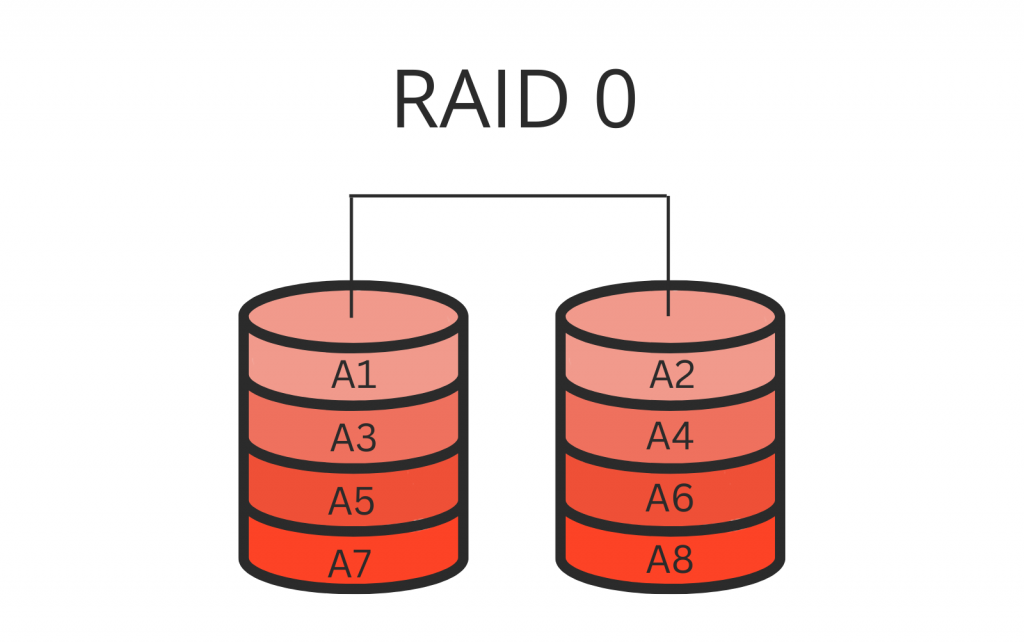What is striping in RAID ? – this is one of the common questions people often encounter when they first start using RAID. In this informative blog post, we will delve into the concept of striping in RAID and provide a comprehensive explanation of its meaning and functionality. By the end of this post, you will clearly understand how striping enhances the performance and reliability of RAID systems.
RAID Striping - How it Works
RAID striping is a technique used to enhance the performance of computer systems that require fast processing speeds and high-capacity data storage. RAID striping involves dividing data into smaller segments and distributing them among multiple hard drives in a RAID disk array.
This process allows data to be accessed and written simultaneously across multiple disks, resulting in faster read and write speeds. Although RAID striping provides significant performance improvements, it is important to note that it does not offer redundancy. If one of the disks in the RAID array fails, all the data is lost.
Overall, RAID striping is a powerful tool commonly used in high-performance systems such as gaming PCs and data centers.
Which Type of RAID is Also Known as Disk Striping
Among the many types of RAID configurations, RAID 0 is also known as disk striping. This type of RAID divides data into blocks and distributes them evenly across multiple hard drives, significantly improving read and write speeds.
RAID 0 has pros and cons, but its most prominent advantage is its enhanced performance, making it a great choice for applications requiring high-speed data processing, such as gaming, video editing, and 3D modeling.
RAID 0 Striping

This means that your computer can read the data from all drives simultaneously, increasing the speed and efficiency of data retrieval. While this approach does not provide any form of redundancy, it is a great choice for those who prioritize performance over data protection. If you’re looking to improve the speed of your computer system, RAID 0 striping is worth considering.
Pros and Cons of Using RAID Striping
Striping RAID is a disk array data storage technique that improves performance by splitting stored data across multiple disks. This results in faster read and write speeds and better overall system performance.
However, while its benefits are undeniable, there are also some drawbacks to using it. One of the cons of striping RAID is that it increases the risk of data loss in case of a hardware failure or other system problems. Additionally, setting up and maintaining RAID levels requires technical expertise and can be time-consuming.
Nevertheless, RAID striping can be the ideal solution for users who require fast access and high performance. Ultimately, the choice between using striping RAID or not depends on each user’s needs and priorities.
Striping RAID Recovery by PITS
In case of data loss due to a RAID striping system failure, having an experienced data recovery company by your side is essential. Raid Recovery Services specializes in recovering data from all RAID configurations, including RAID 0 striping.
Our team of experts utilizes cutting-edge technology and techniques to recover your valuable data quickly and efficiently. Additionally, we offer fast turnaround times and affordable prices, making us the top choice for RAID recovery services. Contact Raid Recovery Services today to learn more about our services and how we can help you retrieve your lost data.
In conclusion, striping in RAID is a powerful technique that allows for improved performance and faster data processing speeds. While it may not offer redundancy, it is a great choice for users prioritizing speed and performance over data protection.
However, it is important to have a reliable data recovery company like Raid Recovery Services to retrieve your valuable information in case of data loss. So whether you’re setting up a RAID system or facing data loss issues, understanding striping in RAID is crucial for making informed decisions and protecting your data.
Frequently Asked Questions
What is RAID striping?
RAID striping involves dividing data into blocks and distributing them across multiple hard drives. This technique enhances computer performance by enabling faster read and write speeds.
What type of RAID is known as disk striping?
RAID 0 is commonly referred to as disk striping.
Does RAID striping provide data protection?
Despite its performance benefits, RAID striping does not offer redundancy or data protection. If one disk fails, all data could be lost.
What are the Pros and Cons of RAID Striping?
The main advantage of RAID striping is its enhanced performance and speed. However, it comes with the risk of data loss in a disk failure. It also requires technical expertise for setup and maintenance.
What is RAID 0 striping?
RAID 0 striping is a data storage method where data is split into segments and spread across multiple drives, allowing for simultaneous reading from all drives and thereby increasing system speed.
Who can help with RAID striping recovery?
Companies like Raid Recovery Services specialize in data recovery from all RAID configurations, including RAID 0 striping. They use advanced technology to recover lost data efficiently and quickly.